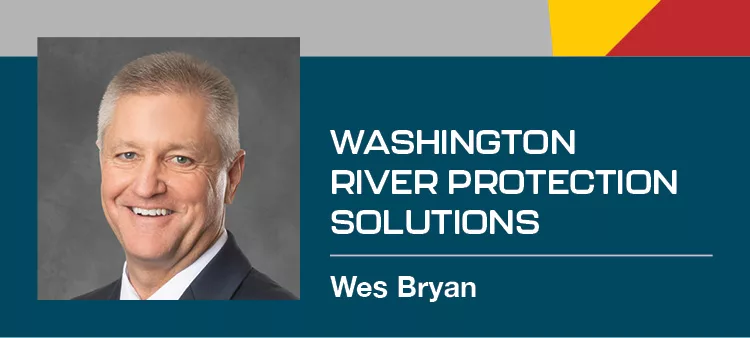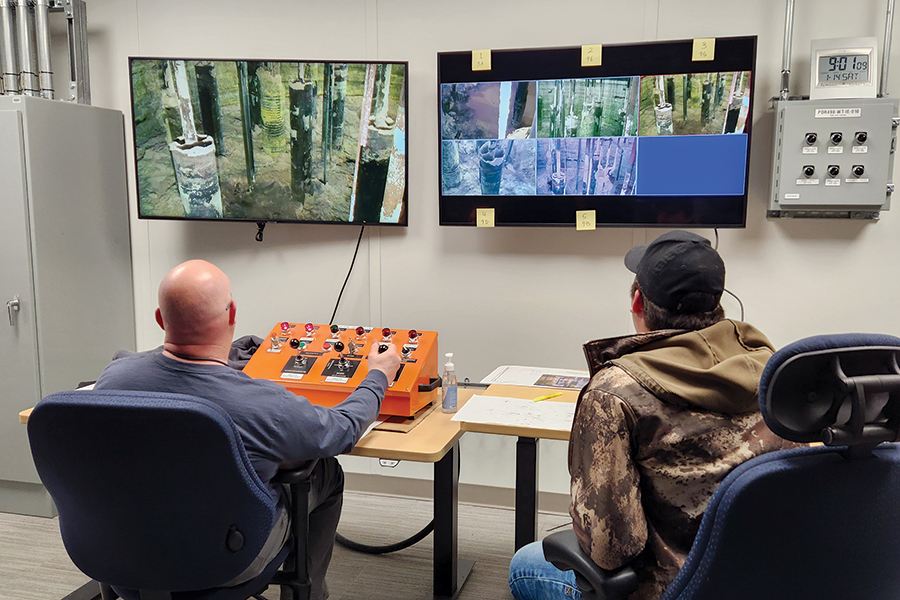
Home » WRPS overcomes challenges to move cleanup mission forward
WRPS overcomes challenges to move cleanup mission forward

April 13, 2023
What a year! I joined the Washington River Protection Solutions team in March 2022. I was told before I accepted the position that the WRPS team is second to none – and I’ve found that to be true. I’m honored to play a very small role on the stellar team that safely overcomes challenges every day to move the cleanup mission forward on behalf of our U.S. Department of Energy client.
The near future of the Hanford site is the Direct-Feed Low-Activity Waste Program (DFLAW), where interdependent projects and infrastructure improvements, managed and highly integrated, will operate together to vitrify, or immobilize in glass, low-activity waste from Hanford’s large underground storage tanks.
WRPS has an integral role in that.
Right now, we have about 440,000 gallons of waste prepared for vitrification through the Tank-Side Cesium Removal System. This is the site’s first industrial-scale tank waste treatment, and represents the crucial, first-step of the tank waste treatment mission. We will continue to treat and stage waste for vitrification, but treating and staging tank waste is only a small part of WRPS’ role in the DFLAW mission.
Our talented construction subcontractors played a critical role in upgrading the Effluent Treatment Facility (ETF). We now have a modern facility, with a capacity doubled to more than 8 million gallons a day, to treat the liquid waste generated during vitrification at the Waste Treatment and Immobilization Plant (WTP) and other facilities.
We will spend the rest of this year testing and exercising the upgraded systems, making certain they are integrating and operating correctly before needed for vitrification.
The DFLAW program requires site-wide integration. We are transitioning to a dynamic mode of 24/7 operations to provide a steady supply of treated tank waste to WTP for vitrification and accept liquid waste at ETF. We are developing and implementing strategies to improve our capability to increase tank waste transfers, operate multiple systems simultaneously, and respond to or recover from emergent operational issues that impact feeding waste to DFLAW. We will rely on our company’s safety culture (and the Hanford site safety culture) to ensure safe, compliant operations.
This will involve every one of our 2,600 employees and subcontractors safely responding to challenges with a sense of urgency, in a disciplined manner, and at a deliberate pace. Our safety culture is strong, and I know our engaged workforce is ready for this next chapter of the Hanford cleanup mission.
A 24/7 operations culture will allow us to support the DFLAW mission, while simultaneously executing other critical tank waste management activities.
The WRPS mission also consolidates radioactive and chemical tank waste from older, single-shell tanks (SSTs) to newer, double-shell tanks (DSTs), then eventually to treatment. Earlier this year, we began emptying the site’s 21st SST. Once that tank is declared retrieved, we will have retrieved the waste from two tank farms, or groups of underground tanks, representing 21 of the site’s 149 single-shell tanks. In parallel, we are making substantial progress preparing the next tank farm for retrieval.

The 242-A Evaporator is a facility critical to our tank waste management mission; it removes water from tank waste, creating more available tank space in the 27 DSTs. We refurbished the boiler ahead of schedule and upgraded transfer lines from a nearby tank farm. Like ETF, the Evaporator system underwent significant maintenance and upgrades, so restoration and operability of this system will require deliberate focus.
All the construction, upgrades, infrastructure improvements and progress mentioned above wouldn’t have been possible without our small business partners. Since 2008, we’ve exceeded our small business subcontracting goals, awarding more than $1.6 billion to small businesses.
As we bring the upgraded and new facilities online and prepare for vitrification, we must grow a workforce that will see us through this new era of the Hanford Site mission. That’s why we are working closely with Washington State University Tri-Cities, Columbia Basin College, and local school districts to develop the next generation Hanford workforce.
We are also proud to partner with several Tri-City organizations that make our region a great place to live so we can attract and retain a workforce that wants to raise families here. We have a lot to offer people of every age. We are fortunate that WRPS parent companies Amentum and Atkins are committed to investing in this community.
This is a dynamic time for WRPS and the One Hanford community. Our collective commitment allows us to overcome unique challenges and achieve tremendous performance at the highest standards while we advance some of the most technically complex and hazardous work on the planet, ultimately improving the community and region for our families. We couldn’t do it without the support of the community and business community, so thank you.
Wes Bryan is president and project manager at Washington River Protection Solutions.
Hanford
KEYWORDS april 2023





